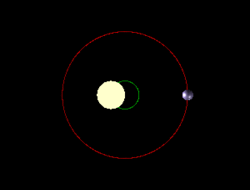Back in 2012, astronomers made a huge announcement: They had found a planet orbiting one of the two stars making up the binary star Alpha Centauri. This made it the closest exoplanet found—as it must be, since Alpha Centauri is the closest star system to the Sun—and not only that, it had a mass only a hair more than Earth’s.
There’s only one problem: The planet almost certainly doesn’t exist.
As problems go, that’s a big one.
Last year, a different group of astronomers examined the same data used to find the planet and showed pretty convincingly the planet is spurious, unreal. The details are complicated, but in the end it’s a product of the way the observations were made and analyzed.
The original observations used what’s called the reflex motion or radial velocity method to look for a planet. A planet orbits a star because of the star’s gravity, of course. But a planet has mass and gravity too, so while the planet makes a big circle around the star, the star makes a little circle at the same time. This means that sometimes the star moves toward us, and sometimes away. That affects its light, shifting it toward the red a tiny bit when it heads away from us, and toward the blue when it moves toward us.

llustration by NASA/Spaceplace
So if you see this periodic shift in the star light, you can detect a planet … theoretically. It’s hard to see that effect from a planet, because it can be swamped by much larger effects. Alpha Cen is a binary, so the two stars revolve around each other at hundreds of meters per second. The stars rotate, smearing out the signal. And stellar activity (star spots and the like) can also produce a similar effect as a planet.
You have to account for all these factors and see what’s left over to look for a planet, and in the end a purported planet’s signal would be very small. If any error creeps in, it can easily wipe out a planet’s signal … or make a false signal look real.
That’s what appears to have happened. The first group found a signal that looked like it was coming from a 1.13 Earth-mass planet orbiting Alpha Centauri B in 3.24 days. The second group reproduced the first group’s work and found that same signal claimed to be a planet. But what they also found was that the way the first group took and analyzed the data may have introduced the signal in the first place; it was like an echo of a real signal (for those who want gnarly details: The time between observations introduced a spike in the power spectrum of the data at 3.24 days; it’s a window function relic of taking discrete observations of a continuous series).
Mind you, this wasn’t a direct error on the part of the first group; the way they analyzed the data was fine. It was an error of omission in a way; they neglected to account for the ways their observational methods might give them false positives. One of them slipped through and made it look like a planet was there when it wasn’t.
I’ll note that not long after the original announcement was made it was called into question, but in my opinion at the time the discussion going back and forth wasn’t conclusive either way, so I waited to write anything. I prefer not to dive in when things are still unsettled in a case like this because it can be harder for the reader to follow along in the long run. I know that happens to me when I read about some medical research, for example, which gets called into question. Media report on every single bit of the back-and-forth, and after a half-dozen of those I can get confused as to what’s what.
In this case, though, the new study looks pretty solid. If I were a betting man (and really, I am) then I’d wager the planet doesn’t exist.
That, to be blunt, sucks. I was very excited when the announcement was made (I rarely use ALL CAPS in a headline), and so finding out it’s wrong is a blow. Scientifically that’s just the way things go sometimes; results on the hairy edge of what can be detected need to be examined with more skepticality than usual, and if they’re found to be spurious, well, there you go.
Still, this one hits home. I love science fiction; I’ve been reading and watching it for my whole life. Alpha Centauri is an icon, a touchstone for alien civilizations; it was used so much that in the aliens-from-Alpha-Centauri book Footfall, authors Larry Niven and Jerry Pournelle actually had their characters joke that an invasion from that star is hard to believe because it’s so cliché.
I mean, c’mon: Zefram Cochrane retired to Alpha Centauri after inventing warp drive in the Star Trek mythos. So yeah, finding an actual planet there was a big deal, and so is losing it.
The good news, such as it is, is that just because these observations didn’t pan out doesn’t mean a planet isn’t there. One or both of those stars in Alpha Cen may very well still have planets, it’s just that this particular observation didn’t root them out. It’s still very much worth looking for them there. Science is full of discoveries made after false detections—this happened with the very first exoplanets ever found, in fact—and I still hold out hope that the nearest star to our own may yet still yield the closest planets to ours as well.
Tip o’ the thermal exhaust port to Brian Koberlein.
